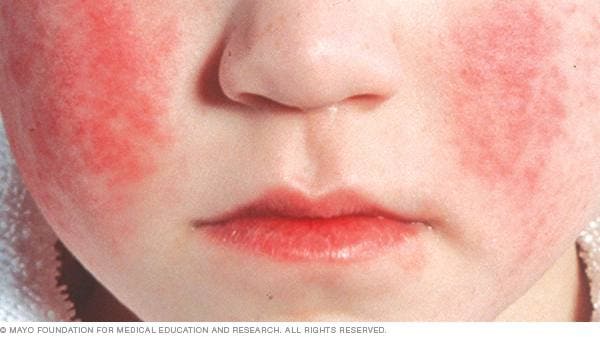Overview
A parvovirus infection is an illness caused by a virus called parvovirus B19.
The illness is most common in children. Adults may get parvovirus, too, if they didn't catch the virus as children. The virus spreads easily through the air and between people.
Children with parvovirus infections often get a face rash. It can look like a slapped cheek. The rash is a symptom of an illness related to parvovirus infections called fifth disease. The rash is red on white skin. It is purplish and harder to see on brown or Black skin. Adults with parvovirus may have joint problems.
Most illnesses caused by parvovirus B19 are mild. People who are pregnant, have weakened immune systems or have blood conditions may need treatment.
You can help prevent a parvovirus infection by lowering your risk of catching the virus that causes it. Wash hands often, cover coughs and sneezes, and stay away from people who are sick if you can.

Parvovirus infection face rash
On white skin, a bright red rash on the cheeks is symptom of a parvovirus infection. The rash looks purplish and is harder to see on brown or Black skin.
Symptoms
Symptoms of infection with parvovirus B19 appear about 5 to 10 days after contact with the virus.
Many people don't have symptoms. But when symptoms do appear, they depend on your age and whether you have health issues that affect the blood or immune system.
Parvovirus symptoms in children
Early symptoms of parvovirus infections in children can include:
- Fever.
- Upset stomach.
- Headache.
- Runny nose.
- Diarrhea.
Face rash
As the body clears out the parvovirus infection, children may get a face rash that looks like a slapped cheek. This is a symptom of fifths disease. The rash is red on white skin. It is purplish and harder to see on brown or Black skin.
Over time, a second rash may form on the arms, leg, chest, back and buttocks. This rash looks pink or purple, lacy and slightly raised. It may be itchy, especially on the soles of the feet.
The rash usually goes away in 7 to 10 days. But it can come and go for up to three weeks. Certain things might make the rash easier to notice. These include a change in weather temperature, time spent in the sun, stress or exercise.
Parvovirus infection symptoms in adults
Adults with parvovirus infections are more likely to get painful, swollen or stiff joints. Joint symptoms may be more common in women than in men. Most often, these symptoms last about 1 to 3 weeks. Joints that tend to be affected are the hands, wrists, knees, ankles and feet.
When to see a doctor
Most people with minor parvovirus infections don't need to see a healthcare professional. But some people have conditions that can make the illness worse or lead to other medical problems. Get a healthcare checkup for symptoms of a parvovirus infection if you or your child also has:
- A blood condition such as sickle cell anemia.
- A weakened immune system.
Also call your healthcare professional right away if you are pregnant.
Causes
Parvovirus infection is caused by a virus that spreads from person to person through sneezing, coughing and saliva. Infections can happen through close contact between people and through hand-to-hand contact.
Parvovirus B19 also can spread through blood or blood products. A pregnant person with the virus can pass it to the unborn baby as well.
Parvovirus B19 is most likely to spread early in an infection, when a person has cold-like symptoms. It's not likely to spread after later symptoms such as rashes and joint pain appear. Most often, it's safe to go back to work or school once the rash shows up.
Other types of parvoviruses exist, but they only infect animals such as cats and dogs. So you can't get infected from a sick pet. You also can't pass parvovirus B19 to a pet.
Complications
A parvovirus infection can lead to other health conditions called complications. The risk of complications is higher for some people, including:
- Those with blood conditions such as anemia.
- Pregnant people.
- People with weakened immune systems.
Parvovirus infection and anemia
Parvovirus infection can cause serious complications for people who have blood conditions such as anemia. With anemia, the body doesn't make enough healthy red blood cells, which carry oxygen. Parvovirus infections in people with anemia can cause a major drop in red blood cells. The risk is very high for people with a type of anemia passed down in families called sickle cell anemia.
Parvovirus infection also can cause anemia and related complications in:
- The unborn children of pregnant people who become infected with parvovirus B19.
- People who have weakened immune systems.
Parvovirus infection in pregnancy
Parvovirus infection during pregnancy sometimes affects red blood cells in the unborn baby. This isn't common but it can cause severe anemia that could lead to miscarriage or stillbirth. The risk to the baby seems to be highest during the first half of the pregnancy.
Parvovirus infection in people with weakened immune systems
Parvovirus infection also can trigger severe anemia in people who have weakened immune systems, which may result from:
- HIV infection.
- Cancers such as leukemia and their treatments.
- Organ transplants or medicines that help prevent the body from rejecting transplanted organs.
Prevention
There's no vaccine to prevent human parvovirus infection. But you can practice healthy habits to lower the chances of getting the illness:
- Wash your hands and your child's hands often.
- Cover your mouth when you sneeze or cough.
- Try not to touch your eyes, nose or mouth.
- Stay away from people who are ill. And stay home when you're sick.
- Don't share food or drinks.
